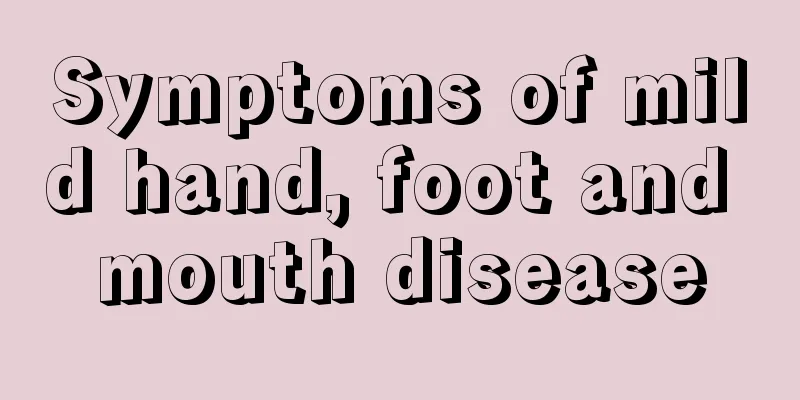What to do if your child's cheeks flare up

|
Many people have not heard of the symptoms of mumps in children, but this phenomenon is very common in our lives, and many children have experienced mumps. Children have weak body resistance and lack the ability to resist bacteria, so when faced with downward cold air, they often develop respiratory infections. Mumps is an infectious disease caused by respiratory tract infection. So what should you do when your child gets mumps? Mumps in children is an acute respiratory infectious disease caused by the mumps virus. It is distributed worldwide and is classified as a Class C infectious disease in my country. It can occur throughout the year, with a peak in winter and spring. It often occurs in children, either sporadically or in an epidemic manner, and may cause outbreaks in collective children's institutions. The clinical symptoms are acute non-purulent swelling of the salivary glands, often accompanied by meningitis, pancreatitis and orchitis. There is no specific treatment drug, and symptomatic treatment is mainly adopted. Causes The pathogen is mumps virus, which has a diameter of about 90 to 135 nm. It is an RNA virus and belongs to the paramyxovirus class. This virus has V antigen (viral antigen) and S antigen (soluble antibody). S antibody may appear in the patient's body one week after infection, reach a peak within 2 weeks, and then gradually decline, and can persist for 6 to 12 months. This antibody does not have an immune protective effect. V antibody appears late and can only be detected 2 to 3 weeks after the onset of the disease. It reaches its peak at 4 to 5 weeks and can still be detected 2 years later. This antibody has an immune protective effect on children. This virus can be killed in ethanol, methanol, and 1% Lysol solution within a few minutes, and can die quickly by ultraviolet radiation. It can survive for a long time under freezing conditions, 9 months at -45℃, 2 months at 4℃, and only 24 hours at 37℃. This virus can also proliferate in the amniotic cavity of chicken embryos and in various tissue cultures (humans and monkeys), and under certain conditions can agglutinate with red blood cells of pigs, chickens, sheep, etc. There are increasing reports of other viruses causing acute mumps. Such as group A Coxsackie virus (Howlett in 1957), parainfluenza virus (Zollar in 1970), herpes simplex virus (Coffin in 1975), influenza A virus (Stuart in 1977), Japanese encephalitis virus (Duan Shucheng in 1981), etc. In 1995, Du Weibao et al. reported 42 cases of mumps caused by Coxsackievirus. complication Mumps in children is not a serious disease in itself, but it has many complications, some of which are more serious. 1. Neurological complications It is reported that about 10% to 20% of cases may have clinical manifestations, including encephalitis (about 5%), meningoencephalitis (about 27%), and encephalomyelitis. Those with cerebellar lesions mainly present with ataxia; those with lenticular nucleus lesions mainly present with torsion spasms; cranial nerve damage and hydrocephalus may also be seen. The overall prognosis is good, but deaths and sequelae are occasionally seen. Meningoencephalitis may occur before, during, or after parotid swelling. Statistics show that the incidence rate is 1.6% in the 6 to 10 days before swelling, 11% in the 1 to 5 days, 2.5% at the same time as swelling, 20.3% in the 1 to 5 days after swelling, 11% in the 6 to 10 days, and 1.6% in the 11 to 26 days. Specifically, meningoencephalitis may occur two weeks before or after cheek swelling. The main clinical manifestations are fever, headache, vomiting, drowsiness, neck stiffness, and in a few cases, coma and convulsions. Since cerebrospinal fluid examination is generally not performed, the exact incidence and changes in cerebrospinal fluid are difficult to know. It is generally believed that the number of cerebrospinal fluid cells is slightly increased, mostly ranging from dozens to hundreds, and occasionally exceeding 1000×106/L. The classification shows that lymphocytes account for the majority, sugar and chloride are normal, and protein is slightly increased. It takes a long time for cerebrospinal fluid to return to normal, usually 3 to 6 weeks. 2. Reproductive organ complications The mumps virus can also invade the reproductive glands, manifesting as orchitis or oophoritis. The former is more common than the latter, which may be related to the ease of clinical detection. This complication is more common in adolescents or adults and is rare in children. It usually occurs 3 to 13 days after parotid gland swelling, and is more common on one side, with only 2% to 3% occurring on both sides. Clinical manifestations include high fever, headache, nausea, vomiting, and local pain. Swelling of the scrotum and redness of the skin. The course of the disease is about 10 days. The incidence of oophoritis is less than that of orchitis, and the clinical symptoms are also mild, with only lower back pain, tenderness in the lower abdomen, and menstrual disorders. It can cause about 30% to 50% of the testicles or ovaries to undergo varying degrees of atrophy, and bilateral atrophy can lead to infertility. 3. Acute pancreatitis It can be seen in older children, and most cases occur 3 to 5 days to 1 week after parotid swelling. The main symptoms are a sudden rise in body temperature, accompanied by repeated and frequent vomiting, severe upper abdominal pain, diarrhea, abdominal distension or constipation. There is obvious tenderness in the upper abdomen, local muscle tension, and B-ultrasound sometimes shows an enlarged pancreas. Blood and urine amylase levels are elevated, but in 90% of simple mumps cases, amylase levels may also be slightly or moderately elevated. Serum lipase determination is helpful in the diagnosis of pancreatitis. In recent years, amylase isoenzymes have been measured to distinguish between parotid gland (P type) and salivary gland (S type) amylase. 4. Sensorineural hearing loss Hearing loss and even deafness are also complications and sequelae of mumps, and there have been reports of this both at home and abroad. This change is not only seen in patients with concurrent encephalitis, but also in children with simple mumps. It has been observed that deafness mostly occurs on one side, with a higher incidence in older children, and most cases occur within 10 days of onset. If concurrent with encephalitis, the incidence of deafness is even higher, about 23.8%. Deafness caused by auditory nerve edema can be recovered in about 6 months by reducing edema and improving local microcirculation. However, deafness caused by degeneration of the auditory nerve often becomes a lifelong damage. 5. Other complications The incidence of mumps complicated by nephritis is about 1.14%, which may occur at the same time as parotid swelling or within 1 week of mumps. In addition to the symptoms of mumps, there may also be low back pain, frequent urination, oliguria, hematuria, eyelid and lower limb edema, and hypertension. Urinalysis showed varying degrees of proteinuria and hematuria. Renal function is mostly normal or temporarily reduced. As mumps improves, the inflammation of nephritis also eases and generally recovers within 3 weeks. Sometimes the virus can be detected in the urine, suggesting the possibility of direct kidney damage by the virus. About 2% to 4% of children with mumps develop myocarditis and pericarditis. The clinical symptoms are mild, and various types of arrhythmias and ST-T changes can be seen on the electrocardiogram. Most patients recover within a few days, but a few severe cases may develop heart failure. There have also been reports of cases of Adams-Stokes syndrome. The concurrent hepatitis rate is approximately 1.25%. There are also a few cases of concurrent arthritis, which often affects large joints, and the symptoms usually disappear within 3 months. In addition, platelets decreased by approximately 2.6%. There are also mastitis, lacrimal gland inflammation, presternal soft tissue edema, facial nerve paralysis, gastrointestinal bleeding and epidemic hemorrhagic fever. treat There is no specific treatment for mumps in children, and symptomatic treatment is the main approach. The child should rest in bed and receive symptomatic treatment until the gland swelling disappears completely. To reduce high fever and acid irritation to the oral cavity, enteric-coated aspirin or acetaminophen can be used. You can use compound boric acid solution to gargle, but sulfonamides and antibiotics are ineffective. Traditional Chinese medicine is a commonly used medicine. Puji Xiaodu Yin can be used for internal use, and Isatis root can be used as a single medicinal ingredient. Whether the topical application of Zijin Ding or Ruyi Jinhuang Powder, mixed with vinegar and then applied externally is really effective needs to be confirmed by strict control observation of a certain number of cases. There are different opinions on whether interferon can accelerate the reduction of swelling and shorten the course of treatment in clinical treatment. Local heat and infrared lamp therapy can also be used. When complicated with orchitis, you can use cotton and a T-band to lift the testicles and apply local cold compresses to relieve pain. In severe cases, hydrocortisone can be used for a short period of time. When pancreatitis occurs, fasting, intravenous fluids and antibiotics should be given. Patients with meningoencephalitis are mainly treated symptomatically, and dehydration therapy can be used for those with increased intracranial pressure. |
<<: What to do if your child is naughty
>>: What to do if your 8-year-old child is disobedient
Recommend
What should I do if my three-month-old baby suddenly refuses to eat milk powder?
Every child is fed with breast milk from birth, a...
What to do if your 2-year-old baby has a fever and cough
As babies grow up, the thing that worries parents...
Reasons why children grind their teeth at night
Many children grind their teeth after sleeping at...
How to treat children with cold, fever and convulsions
Many mothers have found that their children will ...
What should I do if my baby has red spots on the palms and soles of his feet?
The baby's body resistance is very low, and t...
Can babies fall asleep when they are hungry?
Many new parents are unfamiliar with the care of ...
What medicine is good for children's gastrointestinal cold
The healthy growth of children has always been a ...
Two year old baby has blood in stool
Some two-year-old babies will find blood in their...
How to treat children who love coughing
If a child likes to cough, it means that the chil...
Treatment for three-year-old baby who loves to sweat while sleeping
Many of our babies may have the condition that th...
What foods cause children to have early puberty?
The vast majority of children experience precocio...
Factors that cause babies to cry suddenly while sleeping
Babies crying at night has become a headache and ...
What should a four-month-old baby with anemia eat?
As for anemia, many babies nowadays have this con...
What are the symptoms of urticaria in children?
If children suffer from urticaria, it is mostly r...
Why does a child’s face turn red but he doesn’t have a fever?
It is very normal for children to have a fever. E...









